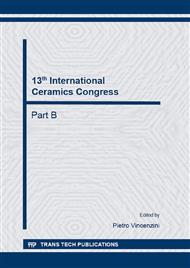p.1
p.9
p.15
p.21
p.31
p.37
p.43
p.49
p.54
Microwave Absorbency Change of Nitride Powders under Vacuum Heating
Abstract:
We measured the microwave and millimeter-wave behaviors of ceramics and metal powders as a basis for developing microwave and millimeter-wave heating technology. In this study, nitride powders were subjected to microwave absorption measurements at elevated temperature. These measurements were performed using a system comprising a vector network analyzer, a circular wave-guide fixture, and a vacuum furnace. The sample’s microwave absorbency was evaluated by the change in reflection power from the sample in the circular wave-guide fixture under vacuum heating. Measurements were performed at approximately 24 GHz and at temperature up to approximately 1100°C. Boron nitride (BN) exhibited almost no absorption of microwaves up to 1100°C, similar to the results of a low-loss oxide powder such as alumina. Dichromium mononitride (Cr2N) powder exhibited a rather high absorption of microwaves at room temperature. During vacuum heating, absorbency of Cr2N started to decrease at 300°C, and became almost zero at temperature greater than 600°C, similar to the behavior of iron powder. This result indicated that roughly packed Cr2N powder absorbs microwave radiation; however, during vacuum heating, the compact body was sintered and the whole sample body became a reflector of microwaves. This change was irreversible, and the sample maintained its reflection behavior upon the cooling. When a mixed powder of Cr2N (20 mass%) and Al2O3 was heated under vacuum, the compact sample exhibited microwave absorption that increased with increasing temperature. This change was reversible upon cooling. These results indicated that the mixed powder did not become reflector of microwaves; Cr2N particles were not electrically connected each other because the Al2O3 particles kept the Cr2N particles separate during the vacuum heating process.
Info:
Periodical:
Pages:
31-36
Citation:
Online since:
October 2014
Authors:
Price:
Сopyright:
© 2014 Trans Tech Publications Ltd. All Rights Reserved
Share:
Citation:


